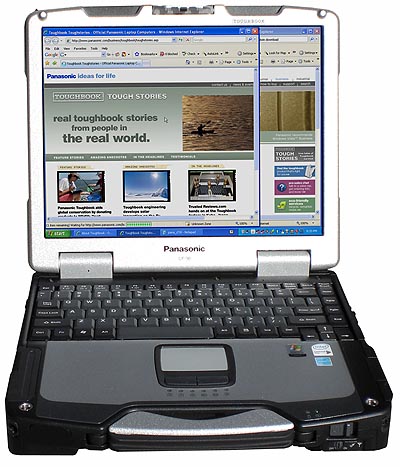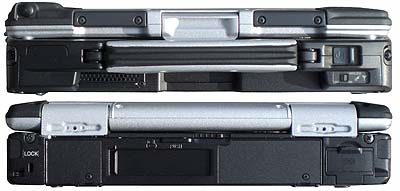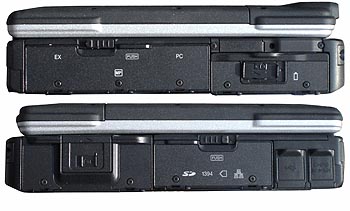Note: In January of 2009, Panasonic updated the Toughbook CF-30 to the latest CF-30K version. This included a switch from the Intel Core 2 Duo L7500 to the ultra low voltage Core 2 Duo SL9300 with vPro(TM) technology that potentially enhances security. Standard memory doubled to 2GB and the standard hard disk capacity also doubled to 160GB (SSDs are now optionally available as well). All CF-30 models now have a 1,000 nit LCD with circular polarization technology and anti-glare and anti-reflective screen treatments to enhance screen viewability, further improving in-field usability for mobile workers. Battery life is said to be up to ten hours now even though the faster replacement processor has the same 17 watt Thermal Design Power as the older chip.
Few computers have the history and pedigree of the rugged Panasonic Toughbooks, and among those the CF-27/CF-28/CF-29 and now CF-30 holds a special place as perhaps the most popular rugged notebook computer ever made. With this design, Panasonic essentially pioneered the concept of a ruggedized mobile computer that is tough enough to be used in the field while still remaining affordable. Panasonic's superb industrial design certainly helped, as did their signature use of highly visible magnesium that lowered weight and provided extra strength and protection. Panasonic also kept its flagship Toughbook model updated over the years, with constant improvements. As a result, it won several Pen Computing Magazine "Editor's Choice" Awards while I ran that publication, and has long been a favorite in law enforcement and numerous other vertical market applications.

The Toughbook Story
How did it all begin? With a relatively small team within the giant Matsushita company of Japan. In a veritable case study of excellence they conceived of a way to succeed in the PC market where others could not. They did that by analyzing the market, finding a niche, and then a product for that niche. They did everything right. The right niche, the right team, vision, perseverance, and probably a degree of luck. Everything clicked, and in one of those rare instances where everything falls into place, the Toughbook became one of the true success stories in mobile computing.
A few years ago I received an invitation from Matsushita to take a closer look at just exactly how Panasonic managed to do it, and I jumped at the opportunity. My travels took me to Japan where I visited Panasonic facilities in Osaka, Kobe, and Tokyo. I also examined Panasonic's stateside service facilities in Kansas. Panasonic was extremely cooperative and gave me a chance to see every aspect of the process, and talk to everyone involved.
I saw first hand that the essence of a "Toughbook" is that each is designed and built to withstand abuse that no ordinary notebook could survive. That involves a lot of research and also plenty of testing and certification. Panasonic performs "torture testing" in its own Kobe facilities, according to both Japanese and US test procedures, and the products also undergo independent tests. In the US, those tests are conducted by the Southwest Research Institute in San Antonio, a non-profit testing agency whose clients include NASA and US auto manufacturers. SWRI performs MIL-STD 810 ruggedization testing.
The most visible characteristics of Toughbooks is their magnesium case. Few computers are as identified with a particular material as Toughbooks are with magnesium. And Panasonic certainly made the most of this association. In the Toughbooks, magnesium is both a design element and a structural feature, and its choice is easily justified. Magnesium, while light and readily available, is also rigid, conducts well, shields electromagnetic waves, and is recyclable. Add to that the high tensile strength and elasticity and it's clear why magnesium has become a desirable material. It's beautiful to look at and very tough.
Working with magnesium, however, isn't easy. It requires great expertise and a major investment in R&D and equipment. Panasonic uses advanced thixomolding, an injection process invented by Dow Chemical in the US, that uses melted magnesium chips and argon gas and offers increased safety and cleanliness, and higher quality parts. At the time I was one of the few outsiders ever to get a tour through Panasonic's magnesium foundry with its thixomolding machines. An impressive sight indeed.
4th Generation Toughbook
The Toughbook shown here is a 4th generation model, called the CF-30. Its external design is virtually unchanged compared to its predecessors as there was little to improve from a design point of view.
However, time does not stand still, and under the hood the flagship Toughbook has undergone massive technology updates. Our review CF-30 that arrived in late 2007 is powered by a 1.66GHz Intel Core Duo L2400 processor. There is a 80GB hard disks, maximum RAM is 4GB of PC4200 DDR2, and the unit has an Express Card/54 slot and a SD Card slot, with a Smart Card slot optionally available. There is Ethernet, of course, an Intel PRO/Wireless 3945ABG module for WiFi, Bluetooth 2.0 + EDR, and a 91 watt-hour main battery that's good for five to eight hours, depending on usage patterns and screen brightness. Depending on options, the CF-30 is mobile broadband ready for Alltel, AT&T, Sprint and Verizon Wireless networks.
A look at Panasonic's global website shows somewhat updated specifications. The CF-30 specs listed there show a 1.6GHz Intel Core 2 Duo L7500 processor with an 800 MHz frontside bus, memory starting at 1GB, use of the Intel Wireless WiFi Link 4965AGN, and the Mobile Intel GM965 chipset. That is likely the configuration available to customers at the time we publish this review (January 21, 2008).
Outdoor viewability issues
Since the form factor of the CF-30 is unchanged from earlier models, Panasonic has not switched (yet) to a wide-format display. What you get here is a 13.3-inch LCD with standard XGA 1024 x 768 resolution. Panasonic offers both a regular display and a touchscreen model.
Touchscreens add a lot of functionality to a mobile computer, but normally reduce outdoor-readability because a resistive touchscreen has four reflecting surfaces instead of just two as in the case with a standard display. An untreated touchscreen reflects up to 20% of the incoming light, which would make the screen unreadable outdoors. It appears that Panasonic applied AR coating on all four touchscreen surfaces and also on the LCD top surface, and that probably cut reflectivity down to about 4%. This would still not be good enough for outdoor viewability, and so Panasonic doubled the backlight brightness of touchscreen-equipped CF-30s from 500 nits to 1,000 nits. This results in an effective contrast ratio of 3.5:1, enough to make the display quite readable outdoors. (For our overview of outdoor-readable screens, click here.)
Real life screen performance
Our review model did not have a touchscreen, but instead came with the standard LCD that has a 500 nit backlight. Consumer notebooks rarely have more than 200 nits because it is not needed indoors, and because bright backlights consume a lot of battery power.
Taking the CF-30 outdoors into the sunlight, I fully expected to be somewhat disappointed and see the screen washing out in direct sunlight. This was not the case. Even facing the sun, I was clearly able to view what was on the display. Like all such screens, having the sun directly reflecting off it caused significant glare, but Panasonic did applied an anti-glare coating that's efficient enough to not only diffuse the glare but also cut down the amount of it. So it's a matter of finding the best angle for optimal viewability.
One slightly irritating characteristic of the display is its greenish cast when it is viewed in direct sunlight. Whites become yellowish-green. However, the display is razor-sharp, there are no weird discolorations that so often mar treated screens, and the experience was much better than I expected.
The unretouched picture below shows the CF-30 outdoors on a fairly bright and cloudless day.

Touch and feel
Even after all these years and having reviewed a good number of Toughbooks, I never cease to be amazed just how perfect they are.
When I visited the Moriguchi Office of Matsushita's Information Technology Products Division on that trip, I learned how even the paint applied to the outer and inner surfaces of a Toughbook makes a difference. The hardness of paint is measured by the same standard as the graphite hardness of a pencil. At that time, paint hardness was 3H but the engineers aimed for 6H which would mean that the paint cannot be scratched by a 6H pencil. For plastics, the acidity in sweat can discolor or break down the paint or the plastic itself. PH levels are important and must be taken into consideration when specifying materials. Since heat dissipation is always an issue with notebook computers, heat-insulating paints can minimize heat on metal bodies. Water-shedding paints can make water pearl off and a device so painted will be more resistant to dirt. But each change may impact other properties.
All that went through my mind when I examined our review CF-30 with its elegant magnesium body. Every line is just right, the medium-fine powdercoat finish could not be better. Every tiny detail fits and works as it should. The screen hinges are solid as a rock, with just the right amount of resistance. The springloaded screen latch is just brilliant, locking easily and holding the screen case in place, and unlocking just as easily. But that's not all. Two bolt-like bumps on the top left and right of the screen cover neatly fit into sleeved indents on the bottom port of the computer, holding the screen even more securely in place. Should the CF-30 fall and hit the ground at a bad angle, the screen will not twist and break off. It's just another little design detail that can make a difference.
The CF-30 has the signature magnesium handle that's part of the design's distinctive look. Yes, it adds a bit of size and weight, but I like the solution. And it even accommodates a stylus in touchscreen versions of the CF-30.
The CF-30 has a full-scale 87-key keyboard and a pressure-sensitive touchpad with a vertical scrolling area. The keyboard is clearly marked and offers very good tactile feedback. The touchpad, on the other had, feels sluggish and requires firm pressure to operate reliably. There is room for improvement in that area.
The four sides of the CF-30
Below you can see all four sides of the CF-30. Panasonic chose a variety of different ways to protect and seal ports and slots. Some -- like serial, USB, and power -- have individual plugs made of hard rubber. They can easily be replaced should they break. Others are grouped together and sealed with a single cover.
On the left side of the unit, a large door covers the ExpressCard and PC Card slot as well as the Multimedia Pocket.
On the right side, the IEEE1394 jack, the SD Card slot as well as the modem and LAN ports are under a common door. The doors have O-ring seals and spring-loaded latches. The hard disk is also externally accessible. To make sure the door doesn't open inadvertently, a small security latch must be moved before a larger latch can be moved up and the door opened. The battery door uses a similar locking mechanism.
In the back, a large door covers and protects two more USB ports, an external antenna connector, a display port, an expansion connector as well as audio in/out. A slider provides separate access to the expansion connector and the antenna port, and separate inserts to the left and right of the latch can be removed and presumably be replaced with individual covers.


Available options
Computers like the Toughbook CF-30 are used in many different environments and industries, all with different requirements. This is why Panasonic offers a variety of options that customers may or may not need. These include:
- Integrated EVDO and HSDPA wide area wireless
- Integrated GPS
- Backlit keyboard, either sealed rubber or plastic emissive
- SmartCard reader
- Fingerprint scanner
- Combo drive or DVD Multi Drive
- Vehicle mount and desktop port replicators
- Secondary battery for Multimedia Pocket
Ruggedness
The term "rugged" is relative and it is pretty much up to the manufacturer whether they label a product "rugged", "semi-rugged", "business-rugged" or give it some other designation. Panasonic calls the CF-30 "fully rugged" but the data is inconsistent. The CF30's manual, for example, states a very conservative operating temperature range between 41 and 95 degrees Fahrenheit, a far cry from the claim on Panasonic's website that the machine is "fabricated to operate at temperatures over 140 and below -20 Fahrenheit". The latter range seems to originate from the high and low operating temperature tests according to MIL-STF-810F, which the machine passed.
The Japanese website states a three foot drop spec as the CF-30 passed the MIL-STD-810F Transit Drop Test of 26 sequential drops in non-operating mode onto each face, edge and corner from a height of 36 inches. The drop surface was defined as two-inch-thick plywood over a steel plate over concrete, and Windows was booted after each drop.
Panasonic's literature does not specify an Ingress Protection rating. Water resistance was tested according to MIL-STD-810F, 506.4, Procedure 3, which is really only a drip test. Dust resistance was tested with MIL-STF-810F, 510.4, Procedure 1, which is blowing dust. This would suggest an IP51 rating. The CF-30 actually seems sealed well enough to offer IP54 protection (water spray from all directions), and a video on Panasonic's website actually shows waterspray from all directions (see Proof of Toughness).
So is the CF-30 rugged or semi-rugged? That depends on the definition. There is a lot of elegant detail and visually pleasing finish on the machine where others simply put plastic and rubber bumpers, so the CF30 may incur some scratches with rough handling. But it does pass all those MIL-STD tests, I've personally seen it torture-tested. It is way tougher than a standard laptop, no doubt about that.
Bottomline
The Panasonic Toughbook CF-30 comes as close to being a timeless design as it gets with laptop computers. Panasonic created this market almost singlehandedly, and its success is the result of a fortuitous combination of attractive industrial design, reliability and quality, and the long-term commitment of the giant Matsushita company of Japan.
With the CF-30, Panasonic kept their flagship rugged laptop technologically up-to-date with processor and chipset upgrades without giving in to fashion trends like wide-format, glossy displays. This is a supremely competent outdoor-viewable rugged notebook based on a mobile computing platform that's been field-tested in numerous industries and applications for over a decade.
-- Conrad H. Blickenstorfer



